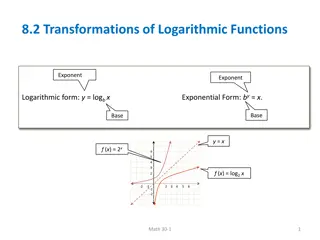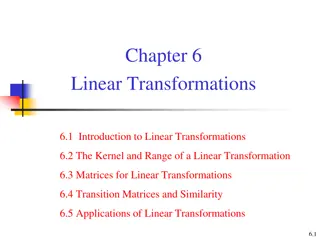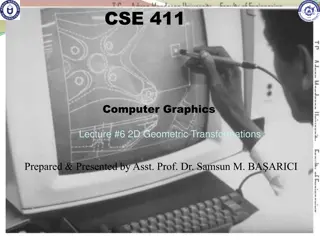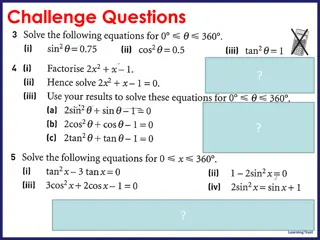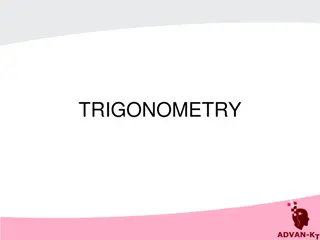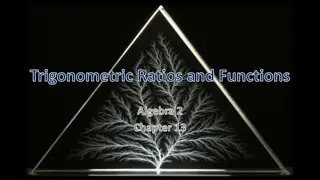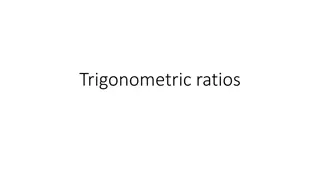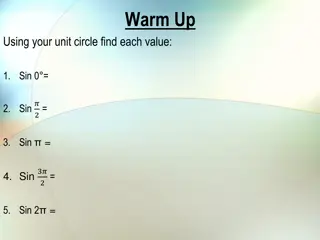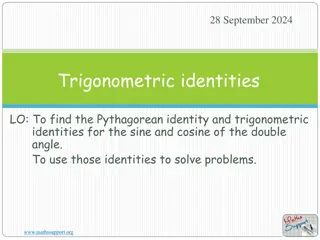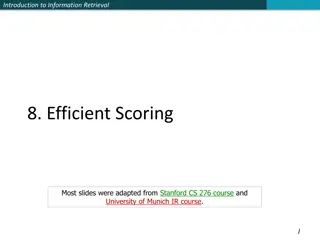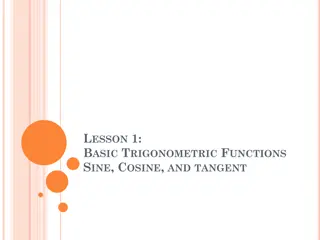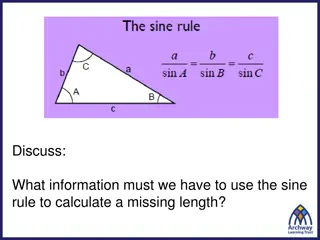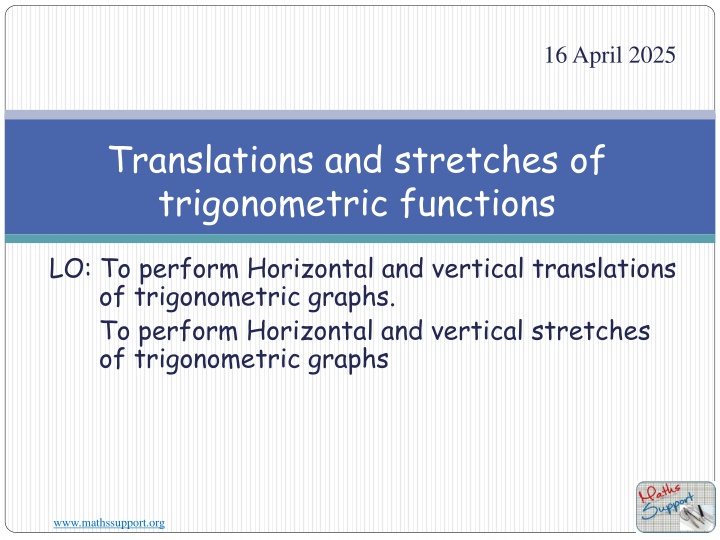
Trigonometric Functions: Translations and Stretches Guide
Learn how to perform horizontal and vertical translations and stretches of trigonometric graphs. Explore the transformations of sine and cosine functions with detailed examples and visual aids. Master the techniques for shifting graphs up, down, left, and right to enhance your understanding of trigonometry.
Uploaded on | 0 Views
Download Presentation

Please find below an Image/Link to download the presentation.
The content on the website is provided AS IS for your information and personal use only. It may not be sold, licensed, or shared on other websites without obtaining consent from the author. If you encounter any issues during the download, it is possible that the publisher has removed the file from their server.
You are allowed to download the files provided on this website for personal or commercial use, subject to the condition that they are used lawfully. All files are the property of their respective owners.
The content on the website is provided AS IS for your information and personal use only. It may not be sold, licensed, or shared on other websites without obtaining consent from the author.
E N D
Presentation Transcript
16 April 2025 Translations and stretches of trigonometric functions LO: To perform Horizontal and vertical translations of trigonometric graphs. To perform Horizontal and vertical stretches of trigonometric graphs www.mathssupport.org
Translations We have seen before that the following are translations of a function f (x) + d translates f (x) vertically a distance of d units upward f (x) d translates f (x) vertically a distance of d units downward f (x + c) translates f (x) horizontally c units to the left f (x c ) translates f (x) horizontally c units to the right. These functions have a period of 360 These functions have an amplitude of 1 y 1 y= sin x 0 90 270 180 360 180 360 x 90 270 -1 y 1 y= cos x 0 360 270 90 270 360 90 180 x 180 -1 www.mathssupport.org
Translations The graphs of these function can be transformed in the same way that you transformed the graphs of other functions If f(x)= sin (x) f (x) + d translates f (x) vertically a distance of d units upward Draw f(x)= sin (x) +2 y 3 f(x)= sin (x) + 2 2 1 f(x)= sin x x 360 270 180 180 90 360 0 90 270 -1 -2 www.mathssupport.org
Translations The graphs of these function can be transformed in the same way that you transformed the graphs of other functions If f(x)= sin (x) f (x) d translates f (x) vertically a distance of d units downward Draw f(x)= sin (x) 1 y 3 2 1 f(x)= sin x x 360 180 90 270 90 270 0 180 360 -1 f(x)= sin (x) 1 -2 www.mathssupport.org
Translations The graphs of these function can be transformed in the same way that you transformed the graphs of other functions If f(x)= sin (x) f (x + c)translates f (x) horizontally c units to the left Draw f(x)= sin ? + 90 y 3 2 1 f(x)= sin x x 360 180 90 450 270 180 90 0 270 360 450 -1 f(x)= sin ? + 90 -2 www.mathssupport.org
Translations The graphs of these function can be transformed in the same way that you transformed the graphs of other functions If f(x)= sin (x) f (x c)translates f (x) horizontally c units to the right Draw f(x)= sin ? 45 y 3 2 1 f(x)= sin x x 180 270 450 360 270 90 0 360 90 180 450 -1 f(x)= sin ? 45 -2 www.mathssupport.org
Translations The graphs of these function can be transformed in the same way that you transformed the graphs of other functions If f(x)= cos (x) f (x) + d translates f (x) vertically a distance of d units upward Draw f(x)= cos (x) +2 y 3 f(x)= cos (x) + 2 2 1 f(x)= cos x x 180 270 90 360 0 360 90 450 180 -1 -2 www.mathssupport.org
Translations The graphs of these function can be transformed in the same way that you transformed the graphs of other functions If f(x)= cos (x) f (x) d translates f (x) vertically a distance of d units downward Draw f(x)= cos (x) 1 y 3 2 1 f(x)= cos x x 90 270 360 180 0 180 360 270 90 -1 f(x)= cos (x) 1 -2 www.mathssupport.org
Translations The graphs of these function can be transformed in the same way that you transformed the graphs of other functions If f(x)= cos (x) f (x + c)translates f (x) horizontally c units to the left Draw f(x)= cos ? + 45 y 3 2 1 f(x)= cos x x 270 180 360 0 450 180 360 90 90 450 270 -1 f(x)= cos ? + 45 -2 www.mathssupport.org
Translations The graphs of these function can be transformed in the same way that you transformed the graphs of other functions If f(x)= cos (x) f (x c)translates f (x) horizontally c units to the right Draw f(x)= cos ? 90 y 3 2 1 f(x)= cos x x 360 180 270 0 90 270 360 180 90 450 450 -1 f(x)= cos ? 90 -2 www.mathssupport.org
Translations We can combine horizontal and vertical translations by looking at equations in the form f(x)= sin (x + c) + d Sketch f (x) = sin x (b) f(x)= sin ? 120 (c)f(x)= sin ? 120 + 1 f(x)= cos (x + c) + d In the same set of axis sketch the graph f(x)= tan (x + c) + d (a) f(x)= sin (x) + 1 y The function is shifted 1 unit upward. to the right. and 120 units to the right. The function is The function is shifted 120 units shifted 1 unit up 3 f(x)= sin ? 120 +1 2 f(x)= sin ? + 1 f(x)= sin x f(x)= sin ? 120 1 x 60 240 300 300 360 360 180 0 120 60 180 -1 -2 www.mathssupport.org
Translations Write a sine equation for the following function The function f(x)= sin (x) is shifted 3 units down. So, the equation is f(x)= sin (x) 3 y 3 0 x 180 180 270 90 90 270 360 360 -1 -2 -3 -4 www.mathssupport.org
Translations Write a cosine equation for the following function The function f(x)= cos (x) is shifted 45 units to the right. So, the equation is f(x)= cos ? 45 y 3 2 1 x 180 270 450 360 0 90 90 450 180 360 270 -1 -2 www.mathssupport.org
Vertical stretches We have seen before that when a function undergoes a stretch af (x) stretches f (x) vertically with scale factor a The function f(x) = asinx is the vertical stretch of f(x)= sin x The function f(x) = acosx is the vertical stretch of f(x)= cos x If a > 1, the function will appear to stretch away from the x-axis. If 0 <a <1, the function will appear to compress closer to the x-axis. If a < 0, the function will also be reflected over the x-axis. With the vertical stretch, the amplitude of the sine or cosine function will change from 1 to |a|. The period of the function will not change. www.mathssupport.org
Vertical stretches When the graph of a function undergoes a vertical stretch, every y-value in the original function is multiplied by the value of a. If f(x)= sin (x) Draw f(x)= 3sin (x) The sine curve has been stretched vertically by a factor of 3 The maximum values are at y=3 The minimum values are at y= -3 The amplitude of the new function is 3 The period is 360 y 3 f(x)= 3sin (x) 2 f(x)= sin (x) 1 x 180 360 90 270 450 180 0 90 360 270 450 -1 -2 -3 www.mathssupport.org
Vertical stretches When the graph of a function undergoes a vertical stretch, every y-value in the original function is multiplied by the value of a. If f(x)= sin (x) The sine curve has been stretched vertically by a factor of 1 The maximum values are at y= 2 The minimum values are at y= 1 2 The amplitude of the new function is 1 2 The period is 360 Draw f(x)= 1 2 sin (x) 2 y 3 1 2 f(x)= sin (x) 1 f(x)= 1 2 sin (x) x 90 0 180 360 360 90 270 180 450 270 450 -1 -2 -3 www.mathssupport.org
Vertical stretches When the graph of a function undergoes a vertical stretch, every y-value in the original function is multiplied by the value of a. If f(x)= sin (x) Draw f(x)= -2sin (x) The sine curve has been stretched vertically by a factor of -2 The maximum values are at y=2 The minimum values are at y= -2 The amplitude of the new function is 2 The period is 360 y 3 f(x)= -2sin (x) 2 f(x)= sin (x) 1 x 180 270 90 0 360 270 450 360 450 90 180 -1 -2 -3 www.mathssupport.org
Horizontal stretches We have seen before that when a function undergoes a stretch f (bx) stretches f (x) horizontally with scale factor 1 The functions f(x) = sin(bx), f(x) = cos(bx) represent horizontal stretches of sine and cosine functions. ? When the graph of a function undergoes a horizontal stretch, every x-value in the original function is multiplied by 1 ? We can also say that every x-value in the original function is divided by b. www.mathssupport.org
Horizontal stretches Multiplying or dividing the x-values by a number in this way changes the period of a trigonometric function. If b > 1, the period will be shorter, and the function will appear to compress toward the y-axis. If 0 <b <1, the period will be longer, and the function will appear to stretch away from the y-axis. If b < 0, the function will also be reflected over the y-axis. When a sine or cosine function undergoes a horizontal stretch, the period of the function will change from 360o to 360 ?. www.mathssupport.org
Vertical stretches If f(x)= sin (x) The sine curve has been stretched horizontally by a factor of 1 2 The period has changed to 360 Draw f(x)= sin (2x) ? which is y 3 The maximum values are at y=1 The minimum values are at y= -1 2 f(x)= sin (2x) f(x)= sin (x) 1 x 180 270 360 0 90 450 90 180 450 270 360 -1 The amplitude has not changed -2 -3 www.mathssupport.org
Vertical stretches If f(x)= cos (x) The cosine curve has been stretched horizontally by a factor of 1 3 The period has changed to 360 Draw f(x)= 2cos (3x) and vertically by a factor of 2 ? which is 120 y The maximum values are at y=2 The minimum values are at y= -2 The amplitude has changed, it is 2 3 f(x)= 2cos (3x) 2 f(x)= cos (x) 1 x 360 360 0 180 180 -1 -2 -3 www.mathssupport.org
Thank you for using resources from A close up of a cage Description automatically generated For more resources visit our website https://www.mathssupport.org If you have a special request, drop us an email info@mathssupport.org www.mathssupport.org


